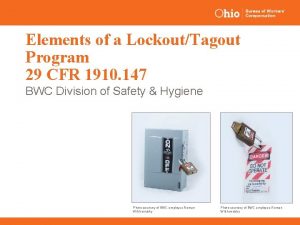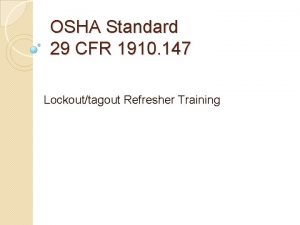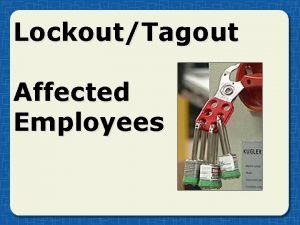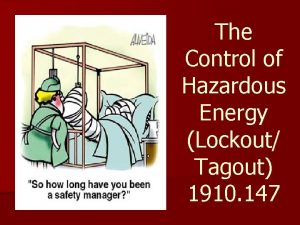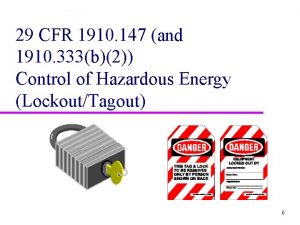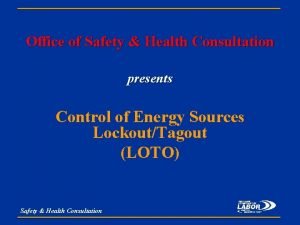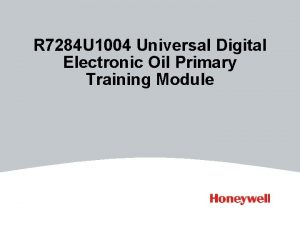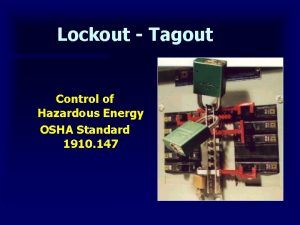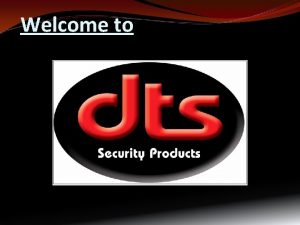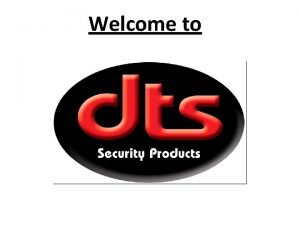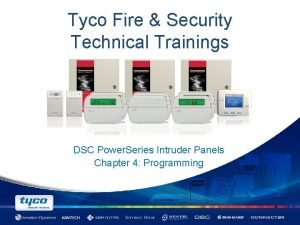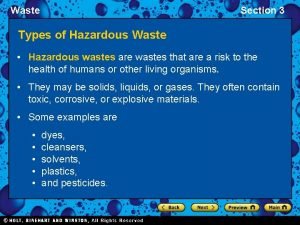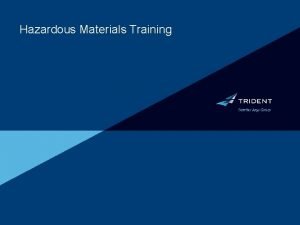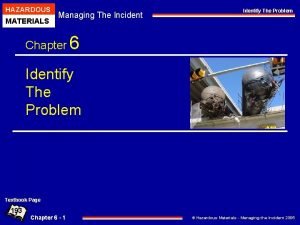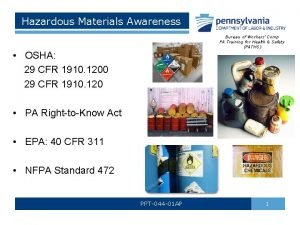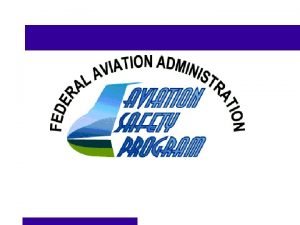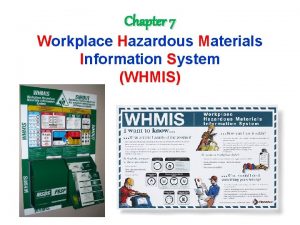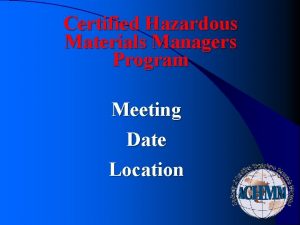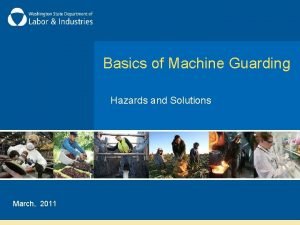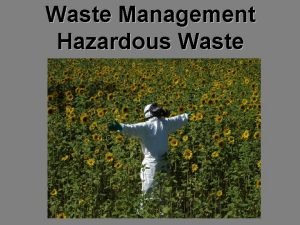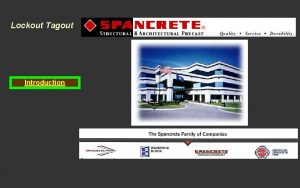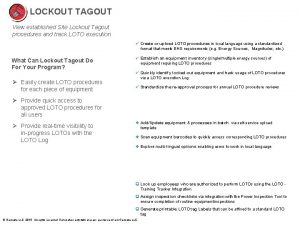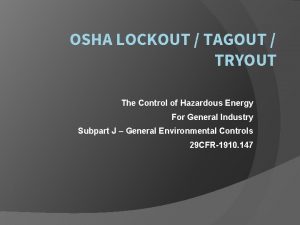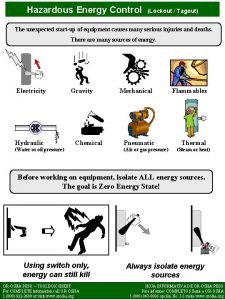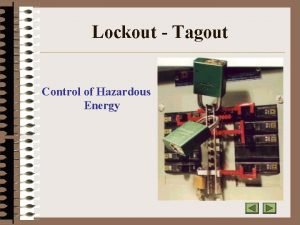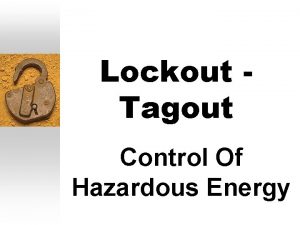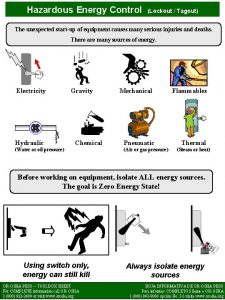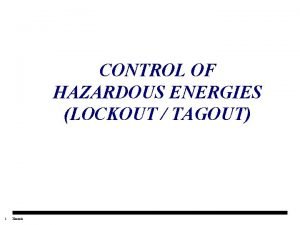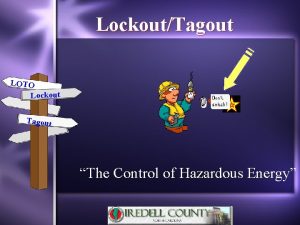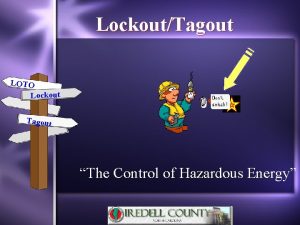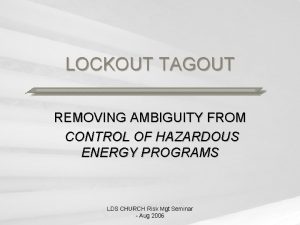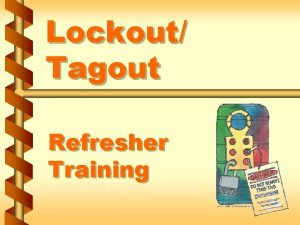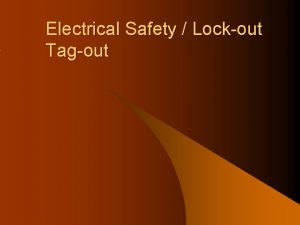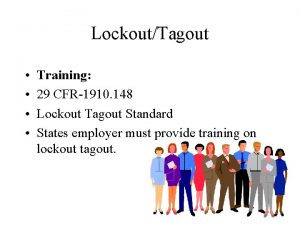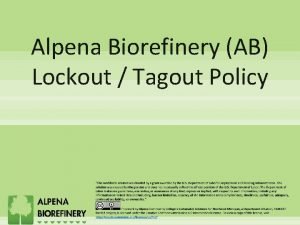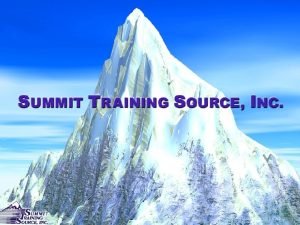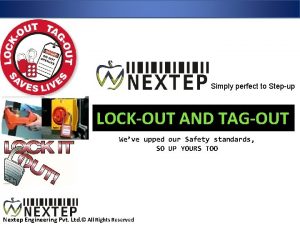LOCKOUT TAGOUT The Control of Hazardous Energy OSHA






























- Slides: 30

LOCKOUT - TAGOUT The Control of Hazardous Energy OSHA Standard 1910. 147 Unknown Arthur www. spin-safety. org

Disclaimer The information presented in this presentation has been compiled from sources believed to be reliable and is intended to be a tool to assist and guide you in building your own presentation. This program may not address all the hazardous conditions or unsafe acts that may exist. For that reason, SPIN cautions users to confirm accuracy and compliance with the latest standards and best practices. Local, State/Provincial and Federal regulations take precedence over this material. Implementation of any practices suggested by this program is at your sole discretion, and SPIN will have no liability to any party for any damages including, but not limited to, direct, indirect, special or consequential damages, arising out of or in connection with the information provided or its use. Unknown Arthur

LEARNING OBJECTIVES n Purpose of Lockout-Tagout n Requirements for LOTO n Types of Hazardous Energy n Procedures for LOTO Unknown Arthur

Types of Energy Electrical n Mechanical n Chemical n Thermal n Hydraulic n Pneumatic n Unknown Arthur

Electric shock can kill n Unknown Arthur as low as 30 volts can carry enough current to kill

Use Safe Electrical Practices n n n Unknown Arthur Use non-conducting tools Check circuits dead before working Lock & Tag source breakers not switches Ensure all control power is deenergized Discharge all capacitors after Lockout

Mechanical Energy Hazards 2 Types Energy: • Kinetic – in motion • Potential - stored Unknown Arthur

Kinetic Energy Hazards Energy of moving machinery can cause n Amputations n Lacerations n Fractures n Loss of life Unknown Arthur

Potential Energy Hazards Energy stored in machinery n Weights & Springs n Pistons under pressure n Hydraulic controls Stored potential energy can be released during work causing injury or death n Unknown Arthur

Chemical Energy Hazards Chemicals have energy that can n start fires n cause skin burns n generate harmful gases or fumes Before working – release, drain or vent chemicals safely Unknown Arthur

Thermal Energy Hazards Energy of Heat (and cold) n n Unknown Arthur Hot equipment & fluids will burn you Cold fluids can cause injury also Quick release of compresses gases can freeze your skin Allow equipment to reach a safe temperature before starting work.

Hydraulic Energy of Liquids Under Pressure n pressure can cause equipment to move n rapid release can cause injury n or ejection of system parts Relieve pressure slowly into a proper container Unknown Arthur

Pneumatic Energy Hazards Energy of Compressed Gases – uncontrolled release can cause injury – rapid de-pressurization creates extreme low temperature Properly vent all systems before starting work Unknown Arthur

First Step In LOTO Know your equipment & systems – hazards – isolation points – procedure for Lockout Working on unfamiliar machinery is a hazard Unknown Arthur

Who Can Lockout Equipment? Only Employees who have been trained and authorized by management Unknown Arthur

Items needed for LOTO n n n n Unknown Arthur Written LOTO schedule Locks & Tags - identified to the worker Hasps - for placing locks & tags Breaker Clips - for electrical LOTO Blank Flanges (pancakes)- for fluid lines Valve Covers - for LOTO of Valves Plug Buckets - for electrical plugs

Use of Locks & Tags n n n Unknown Arthur Use only those issued to you Never use another workers lock or tag Ask your supervisor if you need more LOTO equipment

6 Step LOTO Procedure n n n Unknown Arthur Prepare for Shutdown Equipment Isolate all energy sources Place Locks & Tags Release Stored Energy Verify Equipment Isolation

1. Prepare for Shutdown Understand equipment hazards Notify other workers of shutdown Unknown Arthur

2. Shutdown Equipment Use normal shutdown procedure Turn all switches to OFF Shut all control valves Disable all sources of energy Unknown Arthur

3. Isolate All Energy Sources Shut valves Open breakers & disconnects Unknown Arthur

4. Place Locks & Tags on Valves Breakers / electrical disconnects Block or disconnect all lines Lock and tag blank flanges Unknown Arthur

5. Release or Block all Stored Energy n n n n Unknown Arthur Discharge capacitors Block or release springs Block elevated parts Stop rotating flywheels Relieve system pressure Drain fluids Vent gases Allow system to cool

6. Verify Equipment Isolation n n Unknown Arthur Check all other workers are clear Check locking devices securely placed Check isolation Attempt normal startup Return Controls to OFF/Neutral

Release from LOTO n n n n Unknown Arthur Inspect Area and Equipment Ensure all Machine Guards in place Move tools away from equipment Inform others of startup Restore system connections Remove Locks & Tags Restore equipment to normal Conduct normal startup

Contractors All contractors employees must follow our LOTO procedures! Unknown Arthur

Who can remove Locks & Tags? Only the employee who placed the tag or a supervisor, after obtaining permission from the worker who placed the tag Unknown Arthur

A piece of equipment already has a lock and tag. Do I have to place my own locks & tags? YES. Each person working YES on the equipment must place their own locks and tags to ensure their safety.

Lockout-Tagout Protects YOU! USE Proper Lockout - Tagout Procedures Please be careful when working on equipment Unknown Arthur

As a Safety Professional, SPIN encourages you to submit safety resources that are particularly beneficial to fellow Safety Professionals. We welcome your suggestions and thank you for your input. Please use the following instructions when submitting resources. 1. Please include your full name (first & last) in the subject section of the your email 2. Please include a brief description, name of program and version of any and all files submitted 3. Please use a compression program, like Win. Zip, when submitting multiple or large files 4 Please include appropriate contact information (name, phone number, etc. ) when referring potential new members 5. Include links to safety related URL's in the description section 6. Please send photos and graphic files as 72 dpi jpg, tif or gif files submit all items to: info@spin-safety. org For more information about SPIN visit the web-site at www. spin-safety. org or call 1 -800 -673 -0439
 Bwc 1910
Bwc 1910 Osha 1910 lockout tagout
Osha 1910 lockout tagout Tagout
Tagout Lockout tagout statistics
Lockout tagout statistics Alpena biorefinery
Alpena biorefinery 1910 147
1910 147 A tagout device is preferable to using a lockout device.
A tagout device is preferable to using a lockout device. Lockout tagout wikipedia
Lockout tagout wikipedia Honeywell r7284 running ohms
Honeywell r7284 running ohms Tagout
Tagout Dts garage motor
Dts garage motor Dts gate motor pc board
Dts gate motor pc board Weak lockout mechanism
Weak lockout mechanism Dsc installer lockout
Dsc installer lockout If the actual royalty exceeds minimum rent, it is known
If the actual royalty exceeds minimum rent, it is known Energy energy transfer and general energy analysis
Energy energy transfer and general energy analysis Energy energy transfer and general energy analysis
Energy energy transfer and general energy analysis Section 3 hazardous waste answers
Section 3 hazardous waste answers Aviation hazardous attitudes
Aviation hazardous attitudes Bio medical waste management introduction
Bio medical waste management introduction Hazmat material table
Hazmat material table Hazardous materials table
Hazardous materials table Us military marking system for hazardous materials
Us military marking system for hazardous materials Hazwoper
Hazwoper Five hazardous attitudes
Five hazardous attitudes Avhf
Avhf What shape and color are the whmis 2015 symbols
What shape and color are the whmis 2015 symbols Certified hazardous materials manager
Certified hazardous materials manager Hazardous mechanical motion
Hazardous mechanical motion E-waste definition apes
E-waste definition apes Example of hazardous waste
Example of hazardous waste
